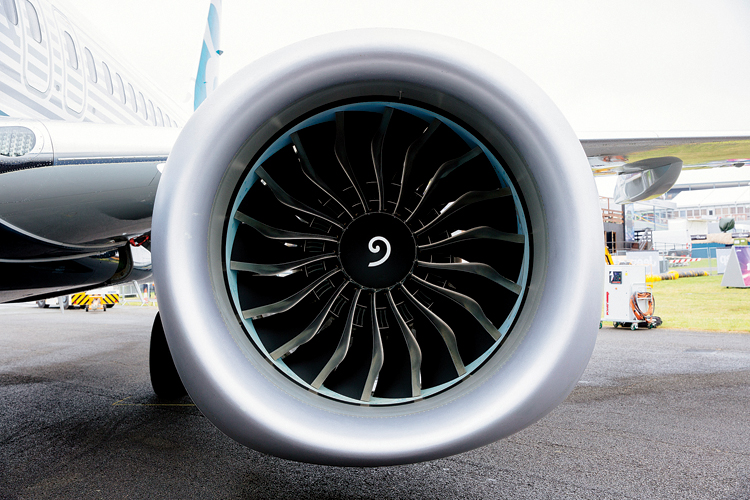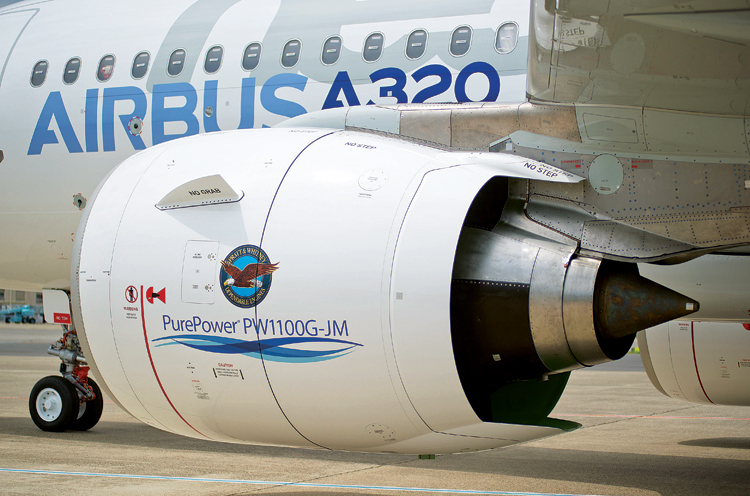INDIAN ARMED FORCES CHIEFS ON
OUR RELENTLESS AND FOCUSED PUBLISHING EFFORTS

SP Guide Publications puts forth a well compiled articulation of issues, pursuits and accomplishments of the Indian Army, over the years

I am confident that SP Guide Publications would continue to inform, inspire and influence.

My compliments to SP Guide Publications for informative and credible reportage on contemporary aerospace issues over the past six decades.
Revving up the Engines
The world’s top jet engine makers are ramping up research and development efforts to cash in on a booming global market for commercial airliners that has produced large orders

At the 2017 Paris International Airshow, the two big giants of the commercial aircraft industry Boeing and Airbus, had new aircraft orders and commitments worth $120 billion, certainly music to the ears of engine manufacturers. With global air traffic projected to double by 2030, led by the Asia-Pacific region, the commercial aircraft industry is on a song. The global aircraft market is projected to register addition of over 32,600 new commercial aircraft through 2034, worth $4.9 trillion. Like the two giants Boeing and Airbus, there are major players in the aero engine segment as well and they include Rolls-Royce, GE Aviation, Pratt & Whitney and CFM International which is a joint venture of GE and Safran.
Rolls-Royce is a pre-eminent engineering company focused on world-class power and propulsion systems. It is one of the world’s leading producers of aero engines for large civil aircraft and corporate jets. It is the second largest provider in the world of aero engines for military aircraft. Rolls-Royce’s Trent XWB is the world’s most efficient large aero engine and the Trent 1000 is the most reliable and durable engine for the aircraft it powers. From these foundations, its future product strategy aims to meet challenging environmental targets with the launch of two new engine concepts, Advance and UltraFan, featuring both new architectures and innovative technological improvements.
20 per cent more efficient from 2020
Rolls-Royce states that Advance will have higher efficiency, fewer parts and lower weight, enabled by a new core architecture. A new lightweight low-pressure system also brings improvements, thanks to a host of innovative system technologies including advanced lightweight alloys and a new carbon titanium fan system, comprising the fan blades and fan casing.
UltraFan: The Ultimate Turbofan
UltraFan features a new geared architecture, ensuring the fan runs at optimum speed, as does the engine compressor and turbine, thanks to the core architecture. The UltraFan is expected to be 25 per cent more efficient from 2025.

Rolls-Royce delivered encouraging year-on-year operational progress in the first six months of 2017; large engine volumes increased 27 per cent. With further growth in the overall value of its order book which includes orders for over 2,700 large engines in civil aerospace which reflects an average five years of production including six years of cover for the Trent XWB family that power the Airbus A-350.
Rolls-Royce has customers in over 150 countries comprising over 400 airlines and leasing customers. It has three common themes across all its businesses – investing in and developing engineering excellence; driving a manufacturing and supply chain transformation which will embed operational excellence in lean, lower-cost facilities and leveraging its installed base, product knowledge and engineering capabilities to provide customers with outstanding service through which it can capture aftermarket value.
CFM International Leap-Frogging
CFM International is a 50:50 joint venture between Snecma (Safran) and GE Aviation. It develops, produces and sells the world’s best selling engine CFM56 engine and the new advanced technology LEAP (leading edge aviation propulsion). The newest LEAP engine meets today’s environmental expectations, delivering a 15 per cent fuel improvement, 50 per cent lower NOx emissions and a 75 per cent reduction in noise versus today’s aircraft. It is a modernised replacement for the successful CFM56 and is intended to compete with the Pratt & Whitney PW1000G in the single-aisle jetliner market.
WITH A LONG HISTORY OF INNOVATION AND GROUNDBREAKING TECHNOLOGY, GE CONTINUES TO SPEND $1BILLION EVERY YEAR ON COMMERCIAL JET ENGINE RESEARCH AND DEVELOPMENT
CFM International’s advanced LEAP engine is setting new industry standards for fuel efficiency and asset utilisation as the company celebrates the first anniversary of its entry into commercial service. The first LEAP-powered commercial flight happened on August 2, 2016 on a Pegasus Airlines flight from Istanbul to Antalya. Since then, more than 75 LEAP-powered aircraft have entered service with a total of 15 operators in four continents. In addition to Pegasus, AirAsia, Air India, Avianca Brazil, Azul, Citilink, easyJet, Frontier, Interjet, Nova Airlines, SAS, SriLankan, Virgin America, Vistara and WOW air have all taken delivery of at least one LEAP-powered airplane. Overall, this fleet has logged over 200,000 flight hours and 1,00,000 flight cycles.
“The LEAP engine entry into service is the most successful in our history and has been exceptional by any measure,” said Gaël Méheust, President and CEO of CFM International. “Our customers are thrilled with the fuel efficiency the engine is providing, as well as the world-class utilisation level they are achieving with this very important asset. Aircraft powered by the LEAP engine are flying more than 95 percent of available days. This is simply unprecedented for a new engine.”
CFM International has delivered over 29,000 commercial engines to date. It has received orders for over 10,000 LEAP engines at a value of $140 billion according to list prices.

Commenting on its achievement to date, CFM International President and CEO Jean-Paul Ebanga said: “We are honoured that airline customers around the world continue to show preference for CFM engines. The CFM56 family is still going strong and we believe LEAP orders will raise demand levels even higher as our technology choices prove themselves in the flight test programmes at Airbus and Boeing.” This year makes the start of the transition to LEAP engine production, with more than 140 units in the plan. The company expects to complete the transition by 2020 with an annual production rate of more than 2,000 engines. CFM will continue to build CFM56 spare engines for many years to support the in-service fleet and plans to produce spare parts for the programme until around the year 2045.
GE using new technologies for engine development
Fairfield, Connecticut-based General Electric Company whose jet engine business, its most profitable operation, is worth about $18 billion. GE is working to develop a commercially viable technique for mass producing engines of carbon fiber and ceramics, materials that are two-thirds lighter than nickel and titanium alloys currently used to make engines.
With over 33,000 engines in service, GE is a world leader in jet engine manufacturing, offering products for many of the best-selling commercial jets. Each one of GE’s commercial engines is a leader in its class for performance, reliability and cost of ownership.
WITH OVER 33,000 ENGINES IN SERVICE, GE IS A WORLD LEADER IN JET ENGINE MANUFACTURING, OFFERING PRODUCTS FOR MANY OF THE BEST-SELLING COMMERCIAL JETS
With a long history of innovation and ground-breaking technology, GE continues to spend $1billion every year on commercial jet engine research and development. Aviation is a most profitable business at GE, next only to its booming energy unit. The company’s operating profits jumped six per cent last year to $3.5 billion while revenues climbed seven per cent to touch $18.6 billion.
For the twin-aisle aircraft, GE has the GE90, GE9X, GEnx, GP7200 and CF6 while for the single-aisle airliners, the engines are CFM56 and LEAP. For regional aircraft, it has the CF34 engine which helped launch the era of regional jets. More than 135 million flight hours and 110 million flight cycles later, it continues to set the standard for performance, durability and dependability.
Pratt & Whitney, from the wasp to PurePower 1000G
Frederick Rentschler founded Pratt & Whitney in Hartford, Connecticut, in 1925. Its first aircraft engine transformed the aviation industry. It was the 410-horsepower, air-cooled Wasp, which delivered unprecedented performance and reliability for the time. Pratt & Whitney hase been leading change ever since.
Today, Pratt & Whitney develops game-changing technologies for the future, such as the PurePower PW1000G engine, with patented Geared Turbofan engine technology. The company’s worldwide large commercial engine maintenance, repair and overhaul network provides innovative services that add value and delight customers around the globe.
Pratt & Whitney’s large commercial engines power more than 25 per cent of the world’s mainline passenger fleet. The company continues to develop new engines and work with its partners in International Aero Engines and the Engine Alliance to meet airline customers’ future needs.
Pratt & Whitney, Canada, has produced more than 80,000 engines, of which there are currently more than 50,000 engines in service by more than 10,000 operators in 200 countries.
The world’s top jet engine makers are ramping up research and development efforts to cash in on a booming global market for commercial airliners that has produced a huge number of orders. They are all indeed revving up their engines.





